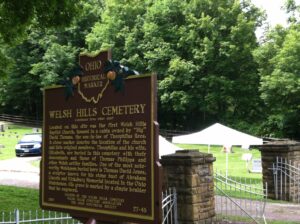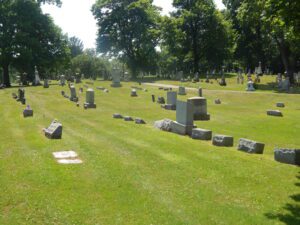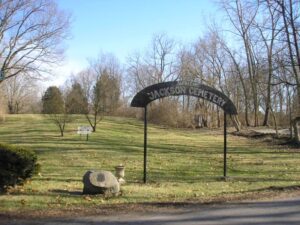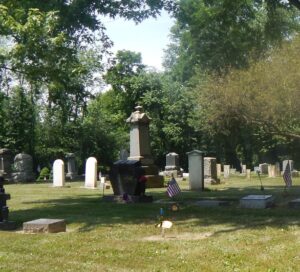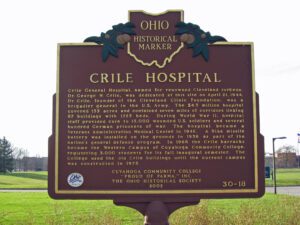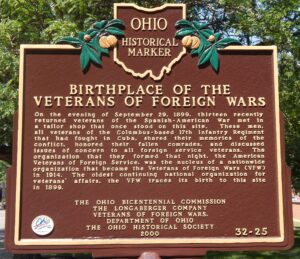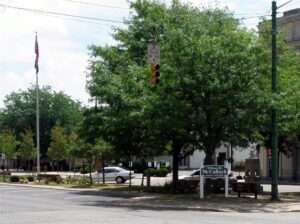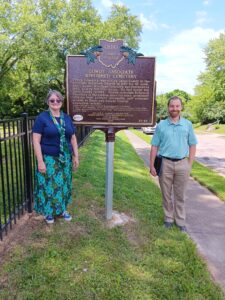, OH
Welsh Hills Cemetery was once part of the United States Military Tract given to veterans of the Revolutionary War. The land was owned by a Philadelphia Welshman named Samson Davis. On September 4, 1801, a portion of his land was purchased by the co-founders of the Welsh Hills community, Theophilus Rees and Thomas Philipps, who came from Carmarthenshire, Wales. On February 6, 1808, Theophilus Rees donated a portion of his land for the establishment of this cemetery. On that same day, Rees Thomas, the 8-year-old grandson of Theophilus Rees, became the first person interred. (Continued on other side)
, OH
For more than two centuries, this burial ground has been a final resting place for those individuals whose lives represented the community history of Canfield. The earliest existing tombstone marks the death of Huldah Tanner in 1803. Seven earlier deaths in Canfield Township are recorded from 1798 to 1803, but the gravesites are unknown. Elijah and Rhoda Hopkins Wadsworth formally deeded the cemetery to the citizens of Canfield in 1810 with a first edition of land donated by Matthew B. Whittlesey in 1811. In 1862-1863, the graveyard was again enlarged. For seventy years the cemetery and fencing were maintained on a volunteer basis. When the Village of Canfield was incorporated in 1869, the care and management was vested in a board of trustees. (continued on other side)
, OH
In 1833, John Randolph from Roanoke, Virginia, died leaving three wills that requested that all of his slaves be set free and that land be purchased for them. Although contested for thirteen years by his family, the slaves were freed and the executor of the wills, Randolph’s cousin Judge William Leigh purchased about 2,000 acres of farm land in Mercer County, Ohio. Traveling by wagon train, the freed slaves, 383 in all, reached their destination in 1846, but were forced to turn back by earlier established white settlers. They turned around and ended up north of Piqua where they purchased land and developed the Village of Rossville. Later some moved on to other places in Miami County and well as Shelby County. In Rossville, they established an African Baptist Church in 1869, cemetery in 1866, and public black school in 1872.
, OH
In 1827, noted evangelist Walter Scott came to Canfield and visited with a number of area Baptist families living on Palmyra Road and in the vicinity of Dean Hill. A follower of Alexander Campbell, Scott delivered powerful sermons that persuaded some to establish a new church congregation in the Disciple faith. After meeting in congregation members’ homes, a framed meeting house was erected circa 1830 on land purchased from William and Orsemus Dean. This church stood across from William Dean’s brick residence. A burial ground was provided at the site with existing grave markers dating to 1837. Veterans from all the wars of this nation are buried here, including Benjamin Dean of the 105th Ohio Infantry Regiment who died from wounds suffered in the 1863 Battle of Murfreesboro in Tennessee. (continued on other side)
, OH
Crile General Hospital, named for renowned Cleveland surgeon, Dr. George W. Crile, was dedicated at this site on April 21, 1944. Dr. Crile, founder of the Cleveland Clinic Foundation, was a brigadier general in the U.S. Army. The $4.5 million hospital covered 153 acres and contained seven miles of corridors linking 87 buildings with 1725 beds. During World War II, hospital staff provided care to 15,000 wounded U.S. soldiers and several hundred German prisoners of war. The hospital became a Veterans Administration Medical Center in 1945. A Nike missile battery was installed on the grounds in 1956 as part of the nation’s general defense program. In 1966 the Crile barracks became the Western Campus of Cuyahoga Community College, registering 3,000 students for its fall inaugural semester. The College used the old Crile buildings until the current campus was constructed in 1975.
, OH
On the evening of September 29, 1899, thirteen recently returned veterans of the Spanish-American War met in a tailor shop that once stood on this site. These men, all veterans of the Columbus-based 17th Infantry Regiment that had fought in Cuba, shared their memories of the conflict, honored their fallen comrades, and discussed issues of concern to all foreign service veterans. The organization that they formed that night, the American Veterans of Foreign Service, was the nucleus of a nationwide organization that became the Veterans of Foreign Wars (VFW) in 1914. The oldest continuing national organization for veterans’ affairs, the VFW traces its birth to this site in 1899.
, OH
William McCulloch was born in Holmes County where he was educated in a one-room schoolhouse before moving to Wooster to attend high school and the College of Wooster. He attained prominence as Ohio’s Speaker of the House from 1939-1943 and House member from the Fourth Ohio Congressional District from 1948-1973. During his time in Washington, McCulloch was best known as a co-sponsor and staunch advocate of the Civil Rights Act of 1964. He was recognized by President Lyndon Johnson as the prime mover for passage of this landmark legislation. As a conservative Republican voice in the House, he was instrumental in championing other civil rights legislation, including fair housing and public accommodations. McCulloch was a founding partner in 1928 of the Piqua law firm that bears his name.
, OH
Gowdy Cemetery was sold by James Gowdy to the Associate Reformed Church in 1820 for 50 cents. After Xenia’s Woodland Cemetery was chartered in 1845, Gowdy fell into disuse. Its last burial was James Gowdy in 1853. Gowdy Associate Reformed Cemetery is the resting place for many prominent citizens that brought mercantile and economic growth to Xenia and Greene County. Gravesites include:
- Revolutionary War veteran Robert Kendall (1751-1842);
- War of 1812 veterans James (1777-1853) and Robert Gowdy (1732-1831);
- James and Samuel Gowdy (1780-1851), who opened Xenia’s first permanent store in 1806.


